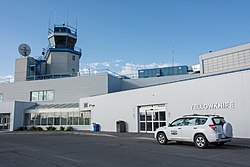Yellowknife Airport Aéroport de Yellowknife [1] | |||||||||||||||
|---|---|---|---|---|---|---|---|---|---|---|---|---|---|---|---|
 | |||||||||||||||
| Summary | |||||||||||||||
| Airport type | Public | ||||||||||||||
| Owner/Operator | Government of the Northwest Territories [2] | ||||||||||||||
| Location | Yellowknife, Northwest Territories | ||||||||||||||
| Hub for | Adlair Aviation, Air Tindi, Buffalo Airways, Canadian North, Northwestern Air, Summit Air | ||||||||||||||
| Time zone | MST (UTC−07:00) | ||||||||||||||
| • Summer (DST) | MDT (UTC−06:00) | ||||||||||||||
| Elevation AMSL | 675 ft / 206 m | ||||||||||||||
| Coordinates | 62°27′47″N114°26′25″W / 62.46306°N 114.44028°W | ||||||||||||||
| Website | www | ||||||||||||||
| Map | |||||||||||||||
| Runways | |||||||||||||||
| |||||||||||||||
| Statistics (2014) | |||||||||||||||
| |||||||||||||||
| Sources: Canada Flight Supplement [3] Environment Canada [4] Movements from Statistics Canada [5] | |||||||||||||||
Yellowknife Airport( IATA : YZF, ICAO : CYZF) is located in Yellowknife, Northwest Territories, Canada. The airport is part of the National Airports System, and is operated by the Government of the Northwest Territories. The airport has regular scheduled passenger service and a number of freight services. In 2024, the airport handled 604,000 passengers. [6]
Contents
- History
- Airlines and destinations
- Passenger
- Cargo
- Emergency services
- See also
- References
- External links
In 2008 the airport's passenger terminal underwent an expansion to the departure/check-in section, roughly doubling the size of the terminal. [7] The airport is classified as an airport of entry by Nav Canada and is staffed by the Canada Border Services Agency (CBSA). CBSA officers at this airport can handle general aviation aircraft only, with no more than 15 passengers. [3]
The Royal Canadian Mounted Police (RCMP) "G" Division maintains a hangar for its air section just south of the passenger terminal. It is adjacent to a hangar used by the Royal Canadian Air Force (RCAF) to house the CC-138 Twin Otter and other utility aircraft operated by 440 Transport Squadron, a subsidiary of 8 Wing.
Canadian NORAD Region Forward Operating Location Yellowknife is located south-west of the airstrip. It was built for forwarding deployment of the McDonnell Douglas CF-18 Hornet in times of conflict.



